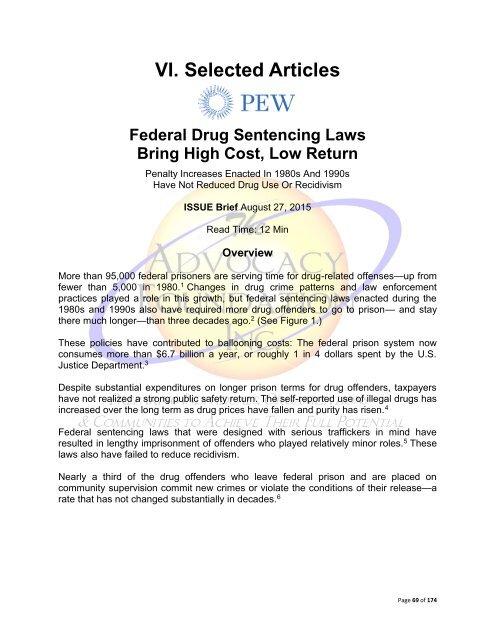The Cost Ineffectiveness of Mandatory Minimum Sentencing In The U.S.
The Cost Ineffectiveness of Mandatory Minimum Sentencing In The U.S.
The Cost Ineffectiveness of Mandatory Minimum Sentencing In The U.S.
- No tags were found...
You also want an ePaper? Increase the reach of your titles
YUMPU automatically turns print PDFs into web optimized ePapers that Google loves.
VI. Selected Articles<br />
Federal Drug <strong>Sentencing</strong> Laws<br />
Bring High <strong>Cost</strong>, Low Return<br />
Penalty <strong>In</strong>creases Enacted <strong>In</strong> 1980s And 1990s<br />
Have Not Reduced Drug Use Or Recidivism<br />
ISSUE Brief August 27, 2015<br />
Read Time: 12 Min<br />
Overview<br />
More than 95,000 federal prisoners are serving time for drug-related <strong>of</strong>fenses—up from<br />
fewer than 5,000 in 1980. 1 Changes in drug crime patterns and law enforcement<br />
practices played a role in this growth, but federal sentencing laws enacted during the<br />
1980s and 1990s also have required more drug <strong>of</strong>fenders to go to prison— and stay<br />
there much longer—than three decades ago. 2 (See Figure 1.)<br />
<strong>The</strong>se policies have contributed to ballooning costs: <strong>The</strong> federal prison system now<br />
consumes more than $6.7 billion a year, or roughly 1 in 4 dollars spent by the U.S.<br />
Justice Department. 3<br />
Despite substantial expenditures on longer prison terms for drug <strong>of</strong>fenders, taxpayers<br />
have not realized a strong public safety return. <strong>The</strong> self-reported use <strong>of</strong> illegal drugs has<br />
increased over the long term as drug prices have fallen and purity has risen. 4<br />
Federal sentencing laws that were designed with serious traffickers in mind have<br />
resulted in lengthy imprisonment <strong>of</strong> <strong>of</strong>fenders who played relatively minor roles. 5 <strong>The</strong>se<br />
laws also have failed to reduce recidivism.<br />
Nearly a third <strong>of</strong> the drug <strong>of</strong>fenders who leave federal prison and are placed on<br />
community supervision commit new crimes or violate the conditions <strong>of</strong> their release—a<br />
rate that has not changed substantially in decades. 6<br />
Page 69 <strong>of</strong> 174
















